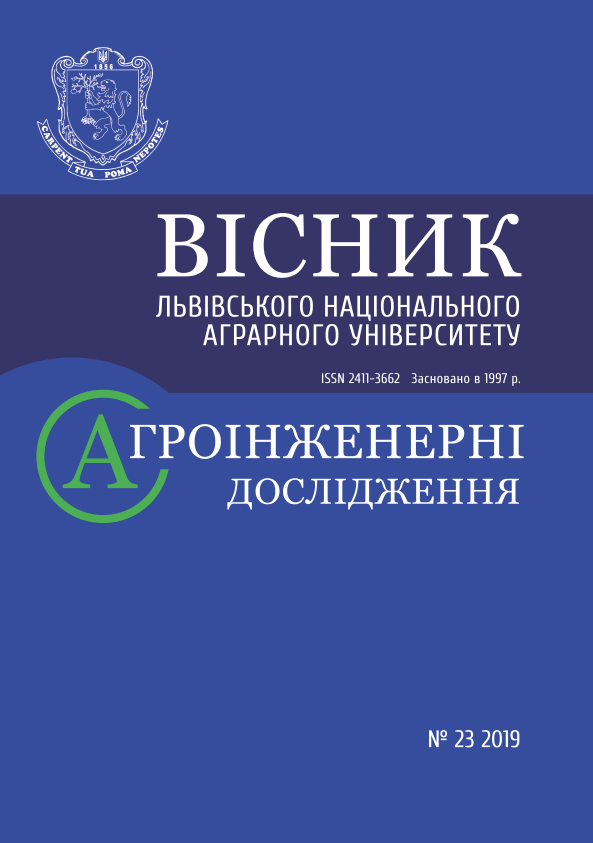INFLUENCE OF CONSTRUCTION OF STARTING AND CONTROLLING EQUIPMENT OF MODERN LED LAMPS ON THEIR OPERATING CHARACTERISTICS
DOI:
https://doi.org/10.31734/agroengineering2019.23.084Keywords:
LED lamps, design of starting-regulating equipment, performanceAbstract
The purpose of the research is to study the ignition design of starting and regulating equipment of modern LED lamps for their performance.
Every year, the issue of energy conservation and energy efficiency becomes more relevant. It is forced by a number of reasons, including: scarcity of energy resources in Ukraine; reduction of natural resources; rising prices for energy imports; annual increase in electricity consumption.
Thus, the problem of energy conservation is of global importance. Up to 20% of the total electricity consumption in the industry comes from lighting. One way to improve energy efficiency is to upgrade lighting, including by the use of modern LED lamps. Nowadays, there is little information on the impact of lighted design of start-up and control devices of modern LED lamps on their performance.
Therefore, the research aims to make experimental investigation of the impact of the design of the PU regulators of modern LED lamps on their performance characteristics.
The research concerns LED lamps at the market of Western Ukraine. Objects of investigation include the Philips, Osram, Feron, Emiligth, Spark, Aukes, Hualin lamps. Completion of the investigated has supplied the following results.
The best heat sink is in the Phillips and Maxus lamps, whch have chips in the circuits, and they are started at higher voltages. Circuits, containing transistors, are started at 140V.
Such manufacturer as Hualin does not use cooling, and this lamp is the cheapest of all manufacturers, as well as the easiest to repair.
Most lamps have RLC filters that reduce ripple on the microcircuits and LEDs. Our experience shows that many LED lamps are of poor quality and do not always meet the specifications of the manufacturers.
References
Ango, A. (1965). Matematika dlia elektro- i radioinzhenerov. Moskva: Vyssh. shk.
Bessonov, L. A. (1973). Teoreticheskie osnovy elektrotekhniki. Moskva: Vyssh. shk.
Bessonov, L. A. (2002). Teoreticheskie osnovyi elektrotekhniki: elektricheskie tsepi. Moskva: Gardariki.
German-Galkin, S. G., & Kardonov, G. A. (2003). Elektricheskie mashiny. Sankt-Peterburg: KORONA print.
German-Galkin, S. G. (2001). Kompiuternoe modelirovanie poluprovodnikovykh sistem v MATLAB 6.0. Sankt-Peterburg: KORONA print.
German-Galkin, S. G. (2007). Silovaia elektronika. Sankt-Peterburg: KORONA print.
Hrechyn, D. P., Herman, A. F., & Drobot I. M. (2016). Kontynualna matematychna model elektromahnitnoho polia asynkhronnoi mashyny iz zubchatym feromahnitnym rotorom. Visnyk Lvivskoho natsionalnoho ahrarnoho universytetu: Ahroinzhenerni doslidzhennia, 20, 34–41.
Hrechyn, D. P., Drobot I. M., Herman A. F., & Dubik V. M. (2016). Vplyv rozmiriv paza rotora na velychynu puskovoho momentu korotkozamknenoho asynkhronnoho dvyhuna. Zbirnyk naukovykh prats Podilskoho derzhavnoho ahrarno-tekhnichnoho universytetu. Tekhnichni nauky, 24 (2), 47–54.
Zhulai, Ye. L., Zaitsev, B. V., Lavrinenko, Yu. M., Marchenko, O. S., & Voitiuk, D. H. (2001). Elektropryvid silskohospodarskykh mashyn, ahrehativ ta potokovykh linii. Kyiv: Vyshcha shkola.
Marchenko, O. S., Lavrinenko, Yu. M., Savchenko, P. I., & Zhulai, Ye. L. (1995). Elektropryvod. Kyiv: Urozhai.
Zakladnyi, O. M., Prakhovnyk A. M., & Solovei O. I. (2005). Enerhozberezhennia zasobamy promyslovoho elektropryvoda: Navch. posibn. Kyiv: Kondor.
Kliuchev, V. I., & Terehov, V. M. (1980). Elektroprivod i avtomatizatsiia obschepromyishlennykh mekhanizmov. Moskva: Energiya.
Moroz, V. I., Paranchuk Ya. S., & Kostyniuk L. D. (2004). Modeli-uvannia elektropryvodiv. Lviv: Vyd-vo NU “Lvivska politekhnika”.
Sokolova, E. M. (2001). Elektricheskoe i elektromekhanicheskoe oborudovanie. Moskva: Masterstvo.
Eliseeva, V. A., & Shinyanskii, V. A. (1983). Spravochnik po avtomatizirovannomu elektroprivodu. Moskva: Energoatomizdat.
Popovych, M. H., Borysiuk, M. H., & Havryliuk, V. A. (1993). Te-oriia elektropryvoda. Kyiv: Vyshcha shk.
Chaban, A. V., Levoniuk, V. R., Drobot, I. M., & Herman, A. F. (2016). Matematychne modeliuvannia perekhidnykh protsesiv u linii Lekhera v stani nerobochoho khodu. Elektrotekhnika i elektromekhanika, 3, 30 – 35.
Chaban, A. V. (2015). Pryntsyp Hamiltona-Ostroh¬radskoho v el-ektromekhanichnykh systemakh. Lviv: Vyd-vo Tarasa Soroky.
Chernyih, I. V. (2008). Modelirovanie elektrotehnicheskikh ustroistv v MATLAB, SimPowerSistems i Simulink. Sankt-Peterburg: Piter.
Mayr, O. (1943). Beitriige zur Theorie des statischen und des dyna-mischen Lichtbogens. Archiv fur Elektroteehnik, 1943’37, 12, 588–608.


